
ABOUT NIBBI BROTHERS GENERAL CONTRACTORS
Nibbi has been constructing technically complex, iconic structures in the San Francisco Bay Area since 1950. The company has the knowledge and experience required to deliver the region’s most challenging, logistically difficult, and sustainable projects. Nibbi bases its success on the continued and
focused application of three key strategies: The Right Goals, The Right Team, The Right Approach.
 Nibbi bases its success on the continued and focused application of three key strategies: The Right Goals, The Right Team, The Right Approach.
Nibbi bases its success on the continued and focused application of three key strategies: The Right Goals, The Right Team, The Right Approach. Servicing our clients and community by building safely with integrity, innovation and quality.
Situation
Nibbi has learned from decades of experience that the right approach is honest, collaborative, proactive, and supported by advanced technology. Nibbi knows that early team collaboration and proactive problem-solving can help maximize quality and avoid significant problems down the road. Their expert use of technology leads to fewer change orders and related budget/schedule impacts.
In addition, Nibbi is unique in that it employs architects in-house, primarily focused on reviewing design drawings for buildability, cost, and risk mitigation, making Nibbi’s QA/QC department more robust than other GCs who typically tackle these issues when they start construction.
Nibbi QA Project Manager Anita Hsieh, a licensed architect, is tapped into the architecture and QA/QC communities and keeps abreast of new technologies and tools. “We try to keep an eye on things that are making waves, but we’re very cautious about jumping into anything until we can see how we can use the tools for projects that are on the books,” said Hsieh. “Testing new software takes a lot of time and there has to be an investment on both sides.”


Opportunity
Several years ago, one of Nibbi’s Project Executive’s brought Firmus to the team’s attention as a company using AI to review design plans. “If there are technologies that exist that could either make us more efficient, more productive, improve the quality of our buildings, then we’d be foolish not to take a look,” said Mukesh Darke, Director of Information Technology at Nibbi.
— Mukesh Darke, Director of Information Technology
Initially, when AI was emerging in the construction space, no one understood exactly how it worked and many people felt it might threaten their job security. “I was actually excited about the possibility that it could save me some time on mundane tasks,” said Hsieh. “Once we saw Firmus’ analysis firsthand, my reaction was, okay, these are things that I would probably not even get to just because I don’t have the time to sift through drawings and look at all the little things that might be missing. But now that I have a tool that shows me pages are missing, tags are missing, discrepancies are present, I’m like, wow, this is important information.”
Hsieh continued, “I think in the beginning it was more of me building trust with the tool. All these things were found, and I spent some time fact-checking, and I realized, okay, all these things are correct, and maybe they’re repetitive, but that’s what the tool is supposed to do, right? I think it’s been great, now that I have built that trust, I don’t have to spend time backchecking the findings. It’s been great to know that I have the confidence that I know what it’s doing, and it’s comfortable with the content that I’m feeding it.
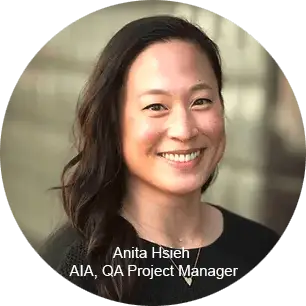

Benefits
Firmus’ AI analyzes construction drawings to identify design related issues early, reducing the chance of costly mistakes and disputes. It provides insights for informed decision-making, and empowers professionals by automating mundane and time-consuming tasks, allowing them to focus on strategic project aspects and improving job satisfaction. Nibbi leverages Firmus AI for efficiency, actionable insights, and collaboration.
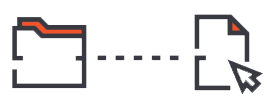
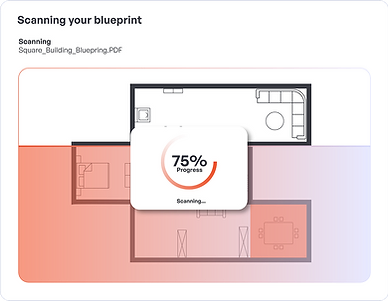
“At the end of the day, I can sleep better knowing I did as thorough a job as I could with the tools I had.”
— Anita Hsieh, AIA, QA Project Manager
01. Efficiency
Nibbi’s QA/QC team is accustomed to spending a lot of time on deep dives into their projects to ensure success. Adding Firmus to their set of tools provides a high level of consistency and takes a significant load off the team related to those more tedious tasks.
“Having a tool like Firmus, with the number of projects we have at any given time, helps accelerate the rate at which we can turn the projects around. Since we have to prioritize what we can do within the allotted time we have, it helps expedite things. Being able to quickly assess the volume and extent of issues, enables me to decide, for example, I’m not going to spend more than three days looking at this because the drawing set isn’t developed enough.”
When the QA/QC team hands things off to the operations side of the house, “I think they appreciate that it does take some load off them as well. They don’t have to find these minuscule problems six months into construction, which then results in wasted time, resources, or budget. At the end of the day, I can sleep better knowing I did as thorough a job as I could with the tools I had,” said Hsieh.
02. Actionable Insights
Firmus AI analyzes construction drawings to identify incomplete design, scope gaps, missing information, and discrepancies. It allows users to efficiently address identified issues, ensuring project accuracy, and enabling them to gain a competitive edge. “It’s a comfort in knowing right off the bat, for example, these sheets are missing. Another big issue is schedules: door schedules, window schedules, for example, are usually always a little bit anemic or missed. I don’t have to pore through the entire set just to find out that info is missing. I think that’s great because then I can focus on a more difficult, complex detail rather than poring over every window tag,” said Hsieh.
 “I use Firmus on all our projects, mostly multifamily residential, on early CDs, but I’ve lately been
“I use Firmus on all our projects, mostly multifamily residential, on early CDs, but I’ve lately been
experimenting with uploading 100% DDs, depending on the developmental level. And that’s been useful, too, because if most of the DNA is there, I can get a head start. We’re also exploring doing a 100% DD and then doing multiple benchmarks, like 25% CD and then 100% CD to see how Firmus can track the same project and potentially the same comments.”
“…I can focus on a more difficult, complex detail rather than poring over every window tag.”
— Anita Hsieh, AIA, QA Project Manager
“One of the trends that has been interesting to see is with the civil drawings. For example, there have been times when the utility connections aren’t coordinated. The existing connections don’t match because they’re not coordinated among the other trades. Those identified issues have been good to see because it’s something that can easily get missed and then when it gets picked up at the beginning of construction, that causes a huge coordination time issue. There have also been issues in MEP drawings — for example, coordination between lighting plans and the architectural reflected ceiling plans that don’t match. It’s just the icing on the cake of things that are definitely important. I can package that information and send it to the architect to review. I don’t even have to summarize it for them. It’s obvious what the issue is and that’s been great.”
03. Collaboration
“We recently had a project where the architect was impressed that we’re using an AI tool. We started scanning drawings, maybe in the mid CDs, and overall, you can sense the level of drawing competency increases each time they submit. I think the architect appreciates having multiple tools at their disposal. It’s more like a team effort. It’s improved the way we interact with them over time. I also I think they appreciate the thoroughness of the reviews we do and the time we’re putting into it. We’re all trying to get the set to be the best it can be.”
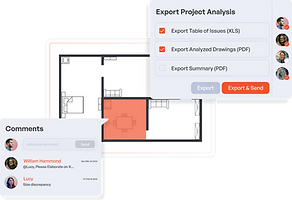 “Because we do a lot of residential projects, Firmus has been able to adapt to the structure of how the drawing sets are done through machine learning. In a typical drawing set, there are overall plans and unit plans. Firmus’ AI has learned to avoid providing redundant comments on unit plans that should reside on overall plans. Being able to adapt to the particular project type has been good because once it learned our drawings, the redundant comments went down. That helps me to not have to sift through a floor plan crowded with comments.”
“Because we do a lot of residential projects, Firmus has been able to adapt to the structure of how the drawing sets are done through machine learning. In a typical drawing set, there are overall plans and unit plans. Firmus’ AI has learned to avoid providing redundant comments on unit plans that should reside on overall plans. Being able to adapt to the particular project type has been good because once it learned our drawings, the redundant comments went down. That helps me to not have to sift through a floor plan crowded with comments.”

— Anita Hsieh, AIA, QA Project Manager
Final Thoughts
“Firmus AI is very easy to work with, and they are great people to work with. They’re genuinely receptive to our input, not just receiving the input and blowing it off. They really do take into account what our thoughts are and appreciate it. And the feeling is mutual,” said Darke.
“It’s been great working with the whole team and I hope we can maintain that grassroots approach,” said Hsieh. “Knowing the people behind the product has been great. Firmus believes in its product, and we believe in it, and its applicability in the construction world. I think that’s ultimately the best part because we’re not just using AI to say we’re using AI. We’re using it now. We’re applying it to projects today.

Mukesh Darke
Director of Information Technology
“We’re going to be part of it. It’s like helping to steer the development and see it grow, just like watching a building come out of the ground.”
— Mukesh Darke, Director of Information Technology
“It’s also been exciting to report our success to internal teams. We’re on the cutting edge and it’s been great to see the QA/QC department evolve with technology. It’s nice to see our processes become more streamlined and that we’re keeping up with the times. I’m excited to see what Firmus’ future has in store,” commented Hsieh.
“We’re going to be part of it. It’s like helping to steer the development and see it grow, just like watching a building come out of the ground,” said Darke.
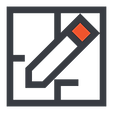
ABOUT
FIRMUS
Firmus’ easy-to-use platform enables general contractors, developers, and AEC stakeholders to detect and mitigate design issues early. Adopted by some of the largest construction and design-build firms in North America, Firmus’ solution increases efficiency and bid accuracy while mitigating risk. Securely managed from a single cloud-based platform, Firmus provides the most reliable and cost-effective design review AI in the industry.
